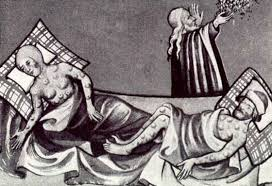Introduction
Imagine living in a world where an invisible force reshaped the very fabric of society. This was the reality of 14th-century Europe during the Black Death, one of history’s most devastating pandemics. But beyond the horror, this catastrophic event became a powerful catalyst for change, leaving an indelible mark on European history. Let’s delve into how this plague, while terrifying, ultimately transformed Europe forever.
What Was the Black Death?
The Black Death refers to a massive outbreak of the bubonic plague that swept through Europe between 1347 and 1351. It originated in Central Asia and spread via trade routes, carried by fleas on rats that infested ships and caravans. The disease earned its grim nickname from the dark spots it caused on victims’ skin.

The Symptoms
Victims of the Black Death experienced excruciating symptoms: high fever, chills, swollen lymph nodes (known as buboes), and blackened skin patches. Death often followed within days, leaving little time for families to react or prepare.
How Did the Black Death Spread?
The interconnectedness of medieval Europe, primarily through trade, played a significant role in the rapid spread of the plague. Ports like Venice, Genoa, and Marseille became epicenters as infected ships docked. Urban areas, with their dense populations and poor sanitation, became breeding grounds for the disease.
The Death Toll
Historians estimate that the Black Death wiped out 25-30 million people in Europe roughly one-third of the continent’s population. Entire towns were abandoned, and fields lay fallow as communities struggled to cope with the loss.
Social Impacts
Collapse of Feudalism
The massive loss of life upended the feudal system, which relied on a stable peasant workforce. With so many laborers dead, surviving peasants demanded better wages and living conditions, setting the stage for the decline of feudalism.
A Shift in Power Dynamics
The scarcity of workers gave laborers unprecedented bargaining power. For the first time, common people could negotiate terms, challenging the rigid class hierarchies that had defined medieval society.
Economic Consequences
Labor Shortages
The labor shortage caused by the Black Death drove up wages and spurred innovation. Landowners began experimenting with more efficient agricultural practices and even transitioning to sheep farming, which required fewer workers.
Growth of Urban Centers
As rural populations dwindled, survivors gravitated toward cities in search of opportunities. This migration contributed to the rise of vibrant urban centers that would later fuel the Renaissance.
Religious Repercussions
Crisis of Faith
The Church, a central pillar of medieval life, faced a crisis as people questioned why God had allowed such suffering. Clergy members, who were not immune to the disease, died in large numbers, further eroding the Church’s authority.
Rise of Religious Movements
In response to the plague, new religious movements and practices emerged. The Flagellants, for instance, roamed Europe, whipping themselves in public displays of penance, hoping to atone for humanity’s sins and end the suffering.
Cultural and Intellectual Shifts
A New Perspective on Life
With death ever-present, people began to adopt a more carpe diem attitude. This shift in mindset paved the way for the flourishing of art and literature during the Renaissance, as individuals sought to capture the beauty and fragility of life.
Advances in Medicine
The Black Death also prompted advancements in medicine. Although medieval doctors lacked the tools to understand the disease fully, the pandemic highlighted the need for better medical practices and public health measures.
Urban Planning and Sanitation
The Black Death underscored the importance of urban hygiene. In its aftermath, cities began implementing measures like waste disposal systems and quarantine regulations to prevent future outbreaks.
Political Changes
Strengthening of Monarchies
With the feudal system in decline, monarchs gained more power, consolidating their authority over weakened nobility. This centralization laid the groundwork for the modern nation-state.
Legal Reforms
To manage labor disputes and prevent social unrest, governments enacted new labor laws, such as England’s Statute of Labourers, which attempted to cap wages and restrict worker mobility.
Check: The Lost Art of Letter Writing: How Epistolary Relationships Shaped History
The Long-Term Legacy
The Renaissance
The social and economic upheaval caused by the Black Death set the stage for the Renaissance. The decline of feudalism, coupled with a renewed focus on individualism and creativity, ushered in an era of unprecedented cultural and intellectual growth.
Modern Public Health
The lessons learned from the Black Death including the importance of quarantine and disease tracking informed the development of modern public health systems.
Could It Happen Again?
While the world has come a long way in terms of medical knowledge and technology, pandemics remain a threat. Understanding the Black Death helps us recognize the importance of vigilance, preparedness, and global cooperation in combating infectious diseases.
Conclusion
The Black Death was undeniably a tragedy of epic proportions, but it also served as a turning point in European history. From the ashes of devastation arose new social structures, economic systems, and cultural movements that reshaped Europe’s trajectory. In many ways, the world we live in today was forged in the crucible of this medieval pandemic.
FAQs
1. What caused the Black Death?
The Black Death was caused by the bacterium Yersinia pestis, which was transmitted through fleas that lived on rats.
2. How did the Black Death impact the economy?
The Black Death caused labor shortages, leading to higher wages for workers and a shift toward more efficient agricultural practices.
3. Did the Black Death affect the Church?
Yes, the Black Death led to a crisis of faith as people questioned the Church’s ability to protect them, and many clergy members died during the pandemic.
4. How did the Black Death influence art and culture?
The constant presence of death inspired a focus on life’s fragility and beauty, setting the stage for the artistic and intellectual flourishing of the Renaissance.
5. What lessons can we learn from the Black Death?
The Black Death highlights the importance of public health measures, global cooperation, and adaptability in the face of pandemics.


